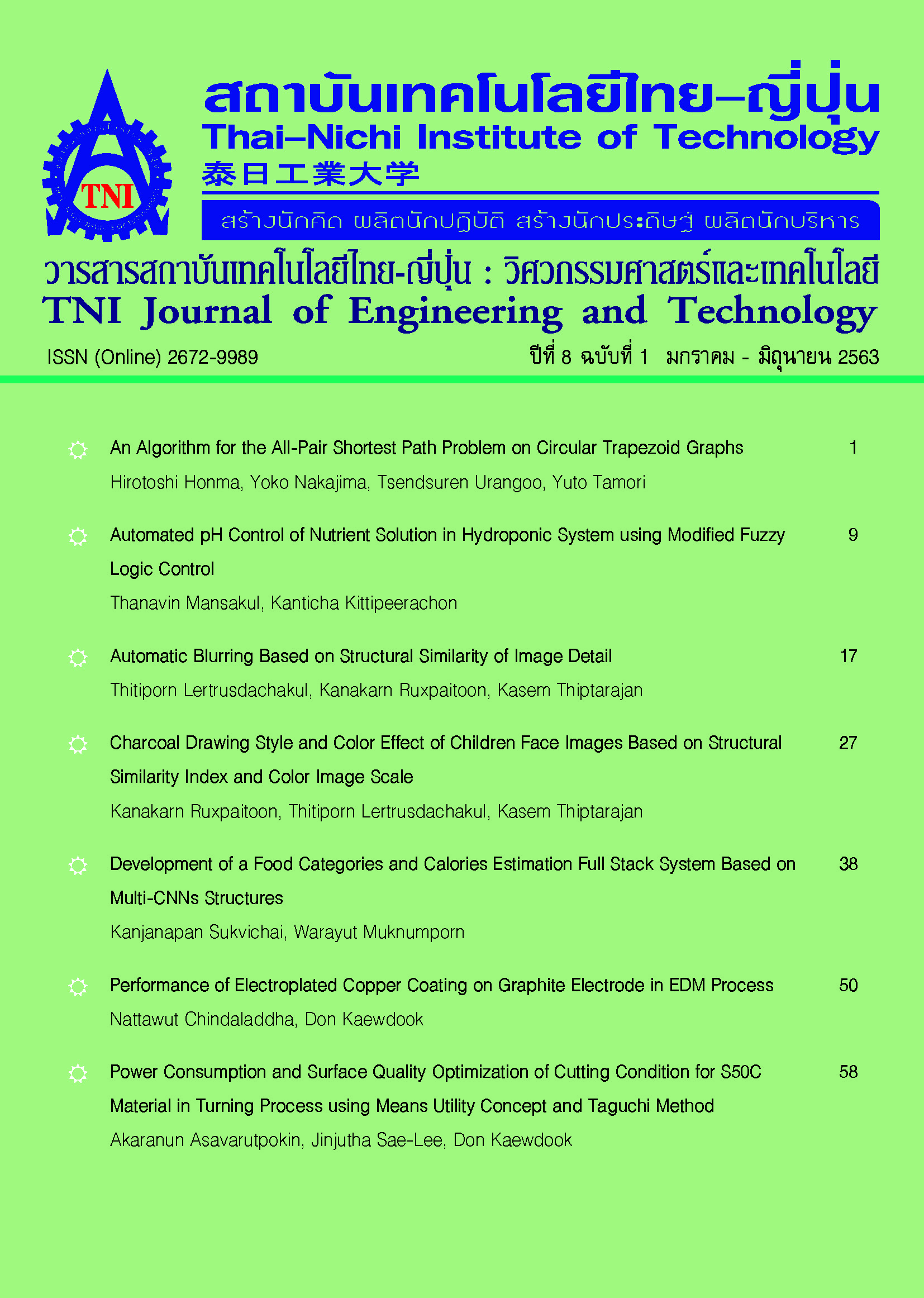Power Consumption and Surface Quality Optimization of Cutting Condition for S50C Material in Turning Process using Means Utility Concept and Taguchi Method
Main Article Content
บทคัดย่อ
This paper aims to study the effects of cutting condition to the power consumption and surface quality in tuning process on mild steel S50C. The machine was used in this study is CNC turning and carbide cutting tool. The optimize process parameters by means utility concept and Taguchi technique applied to identify the machinability and energy efficiency. The three types of process parameters with five different levels including, cutting speed, feed rate, and depth of cut have been used in this work. The selection of these parameters was based on literature review, and tool manufacturing recommendations. The Taguchi orthogonal array L25(53) have been used for conducting the experiments. The results shown that most significant factor for power consumption is depth of cut (60.58%) followed by feed rate (30.27%) and cutting speed (4.36%). For surface roughness, the most significant factor is feed rate (98.49%) followed by depth of cut (0.99%), and cutting speed (0.02%). Nevertheless, the minimum power consumption of machine condition is in contrast to the surface roughness quality. Therefore, this technique can be applied for production planning to control the product quality and machining cost.
Article Details
นโยบายการรับบทความ
กองบรรณาธิการวารสารสถาบันเทคโนโลยีไทย-ญี่ปุ่น มีความยินดีรับบทความจากอาจารย์ประจำ และผู้ทรงคุณวุฒิในสาขาวิศวกรรมศาสตร์และเทคโนโลยี ที่เขียนเป็นภาษาไทยหรือภาษาอังกฤษ ซึ่งผลงานวิชาการที่ส่งมาขอตีพิมพ์ต้องไม่เคยเผยแพร่ในสิ่งพิมพ์อื่นใดมาก่อน และต้องไม่อยู่ในระหว่างการพิจารณาของวารสารอื่นที่นำส่ง ดังนั้นผู้สนใจที่จะร่วมเผยแพร่ผลงานและความรู้ที่ศึกษามาสามารถนำส่งบทความได้ที่กองบรรณาธิการเพื่อเสนอต่อคณะกรรมการกลั่นกรองบทความพิจารณาจัดพิมพ์ในวารสารต่อไป ทั้งนี้บทความที่สามารถเผยแพร่ได้ประกอบด้วยบทความวิจัย ผู้สนใจสามารถศึกษาและจัดเตรียมบทความจากคำแนะนำสำหรับผู้เขียนบทความ
การละเมิดลิขสิทธิ์ถือเป็นความรับผิดชอบของผู้ส่งบทความโดยตรง บทความที่ได้รับการตีพิมพ์ต้องผ่านการพิจารณากลั่นกรองคุณภาพจากผู้ทรงคุณวุฒิและได้รับความเห็นชอบจากกองบรรณาธิการ
ข้อความที่ปรากฏภายในบทความของแต่ละบทความที่ตีพิมพ์ในวารสารวิชาการเล่มนี้ เป็น ความคิดเห็นส่วนตัวของผู้เขียนแต่ละท่าน ไม่เกี่ยวข้องกับสถาบันเทคโนโลยีไทย-ญี่ปุ่น และคณาจารย์ท่านอื่น ๆ ในสถาบัน แต่อย่างใด ความรับผิดชอบด้านเนื้อหาและการตรวจร่างบทความแต่ละบทความเป็นของผู้เขียนแต่ละท่าน หากมีความผิดพลาดใด ๆ ผู้เขียนแต่ละท่านจะต้องรับผิดชอบบทความของตนเองแต่ผู้เดียว
กองบรรณาธิการขอสงวนสิทธิ์มิให้นำเนื้อหา ทัศนะ หรือข้อคิดเห็นใด ๆ ของบทความในวารสารสถาบันเทคโนโลยีไทย-ญี่ปุ่น ไปเผยแพร่ก่อนได้รับอนุญาตจากผู้นิพนธ์ อย่างเป็นลายลักษณ์อักษร ผลงานที่ได้รับการตีพิมพ์ถือเป็นลิขสิทธิ์ของวารสารสถาบันเทคโนโลยีไทย-ญี่ปุ่น
ผู้ประสงค์จะส่งบทความเพื่อตีพิมพ์ในวารสารวิชาการ สถาบันเทคโนโลยีไทย-ญี่ปุ่น สามารถส่ง Online ที่ https://www.tci-thaijo.org/index.php/TNIJournal/ โปรดสมัครสมาชิก (Register) โดยกรอกรายละเอียดให้ครบถ้วนหากต้องการสอบถามข้อมูลเพิ่มเติมที่
- กองบรรณาธิการ วารสารสถาบันเทคโนโลยีไทย-ญี่ปุ่น
- ฝ่ายวิจัยและนวัตกรรม สถาบันเทคโนโลยีไทย-ญี่ปุ่น
เลขที่ 1771/1 สถาบันเทคโนโลยีไทย-ญี่ปุ่น ซอยพัฒนาการ 37-39 ถนนพัฒนาการ แขวงสวนหลวง เขตสวนหลวง กรุงเทพมหานคร 10250 ติดต่อกับคุณพิมพ์รต พิพัฒนกุล (02) 763-2752 , คุณจุฑามาศ ประสพสันติ์ (02) 763-2600 Ext. 2402 Fax. (02) 763-2754 หรือ E-mail: JEDT@tni.ac.th
เอกสารอ้างอิง
A. Hassan and E. H. Gawad, “Cutting cylindrical Surfaces,” in Fundamentals of Machining Processes-Conventional and Nonconventional Processes, 2nd ed. New York, NY, USA: CRC Press Taylor & Francis Group, 2014, ch. 5, pp. 112-158.
G. Y. Zhao, Y. B. Guo, Z. Y. Liu, Y. He, and H. J. Cao, “Energy Consumption in Machining: Classification, Prediction, and Reduction Strategy,” Energy, vol. 133, pp. 142-157, Aug. 2017.
R. C. V. Nostrand, “Design of Experiments Using the Taguchi Approach: 16 Steps to Product and Process Improvement,” Technometrics, vol. 44, no. 3, pp. 289–289, Aug. 2002.
A. Aggarwal, H. Singh, P. Kumar, and M. Singh, “Optimizing power consumption for CNC turned parts using response surface methodology and Taguchi’s technique—A comparative analysis,” Journal of Materials Processing Technology, vol. 200, no. 1, pp. 373–384, May 2008.
C. C. Negrete, “Optimization of cutting parameters for minimizing energy consumption in turning of AISI 6061 T6 using Taguchi methodology and ANOVA,” Journal of Cleaner Production, vol. 53, pp. 195-203, Aug. 2013.
S. A. Bagaber and A. R. Yusoff, “Multi-objective optimization of cutting parameters to minimize power consumption in dry turning of stainless steel 316,” Journal of Cleaner Production, vol. 157, pp. 30-46, Jul. 2017.
N. Jagannatha, S. S. Hiremath, and K. Sadashivappa, “Analysis and Parametric Optimization of Abrasive Hot Air Jet Machining for Glass using Taguchi Method and Utility Concept,” International Journal of Mechanical and Materials Engineering (IJMME), vol. 7, no. 1, pp. 9-15, 2012.
Sandvik, “CNMG 12 04 08-QM 4325,” SANDVIK.COROMANT.com https://www.sandvik.coromant.com/enb/products/pages/productdetails.aspx?c=CNMG+12+04+08-M+4325 (accessed Feb. 18, 2020).


